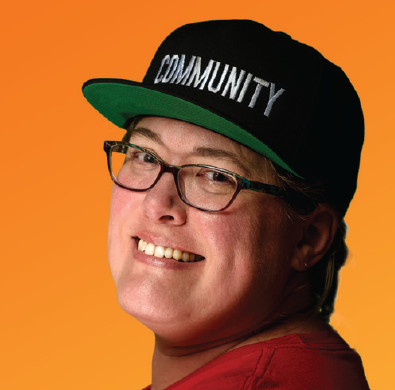Student Poverty? Class Size? We’re On It.
Meet six MSEA activists tackling student poverty, class size, educator salaries, and more.

This is our moment — if we are to be successful in our work influencing the recommendations of the commission to right the $3 billion annual funding deficit that our schools face, we need to educate each other, our communities, and our representatives in Annapolis.
Meet Liz, Ronnie, Dwayne, Betty, Jeff, and Vernon — six MSEA activists who are committed to making the most of a once-in-a-generation opportunity.
They, like other members across the state, have stepped up to raise educators’ voices as the Kirwan Commission addresses the underfunding issues that are in the way of progress.
That’s why you’ll find these members and members like them hosting building and house meetings, making calls, lobbying in Annapolis, attending town halls, and more to make sure educators are heard and their voices respected.
The issues you’re facing in your classroom, your building, and your school are issues MSEA is raising up. Our priorities as we work closely with the commission are to increase staffing to reduce caseloads and class size, address the poverty and non-academic issues that affect our students, and increase the salaries of hard-working educators.
Read on to see how these six members found the connections between their on-the-ground experience in their classrooms and schools and their fight for a world-class education for their students.

Social Justice
Liz Jones, High School English Teacher
LIZ: “I work in one of the wealthiest districts in the state, and yet there are students and entire schools without proper resources. This isn’t acceptable to me. Our system is broken.
“The reality is that we have students who are hungry, who have stayed up late the night before, and who are exhausted from supporting their families with after school jobs or taking care of younger siblings.
“Students are craving a place that values them and allows them to process and discuss the negative stereotypes they face each day, both in their own lives and through the images on the news.
“Students are craving a place that values them and allows them to process and discuss the negative stereotypes they face each day, both in their own lives and through the images on the news.
“Our schools can level the playing field for our students whose lives are made harder by the injustices they face through no fault of their own. I think it is part of my responsibility to create opportunities for my students in ways that honor their individual talents, needs, and life experiences.”
MSEA: When MSEA asked members like Liz to describe the biggest barriers to learning in their classrooms, poverty and student behavior ranked at the top. Making up for the inequalities outside the classroom is a burden felt by nearly every educator in every district.
MSEA chief lobbyist Sean Johnson reports that “the research linking socioeconomic status and poverty to student achievement is so concrete as to be completely daunting.”
A RAND Corporation survey adds that “compared with teachers, individual and family characteristics may have four to eight times the impact on student achievement.”
Many people emphasize the importance of good teachers, and many local, state, and federal policies are designed to…www.rand.org
Poverty dramatically and negatively affects the well-being of children, particularly in the areas of physical health, mental health, safe housing, access to technology, parental support, family planning services and education, youth employment, and nutrition.
Each of these factors play a large role in whether students are able to learn and do well in school — making it imperative that these opportunity gaps be closed if we want to provide equitable education in our communities.

Power
Ronnie Beard, Special Education Instructional Assistant
RONNIE: “Education is power. A high-quality education means our students will be deep and critical thinkers — and make real contributions to their communities.
“A school system is only as good as the resources it provides its students. The power of the kind the Kirwan Commission can provide through funding and support means educators have the tools and conditions they need to prepare students for the workforce — that means a leg up on earning power, social power, and professional power.
“We can use our power as a union to improve instruction, services, and resources by electing state legislators and members of our local school boards whom we can trust.”
“We need a strong, united, and powerful front to create change for the better in our school systems. We must educate our communities so they understand what their children need and deserve from our schools. We can use our power as a union to improve instruction, services, and resources by electing state legislators and members of our local school boards whom we can trust.”
It’s up to the Kirwan Commission to revamp and improve school funding statewidemseanewsfeed.com
MSEA: We’re hard at work building power and influence as we look toward the Kirwan Commission recommendations.
If realized, every one of our priorities — from community schools to increasing educator salaries to decreasing workloads and class sizes — will give those in the system more power. For educators, more time and resources to give to their students; for students, the support each one needs for success; for communities, the promise of rewarding futures for their children.
We’ll be using our access to educate legislators in the GeneralAssembly on how increased staffing in schools exponentially increases the power of academic programs. We’re looking for expanded planning and professional time, release time for mentors, time to engage with parents, in-creased para-educator support, and more teachers in special content areas like the arts and career and tech training.

Our Union
Dwayen Hancock, Building Services Manager
DWAYNE: “As a union, our power is in our numbers — plain and simple. Where else in Maryland can you get 73,000 people organized for common goals?
“Yes, we want contracts that treat us fairly, but we organize mainly to improve public education through supporting great schools for every student.
“Just like our collectively bargained contract binds us together to hold administration accountable to every member, our union membership unites us to fight for our students, schools, and communities.”
“We can do our job as a union by making sure that we have the funding we need to do our jobs — that means improving school instruction, services, and resources. Our united front — and our constant presence in every educational setting — makes us highly qualified as expert and vigilant advocates.
“Just like our collectively bargained contract binds us together to hold administration accountable to every member, our union membership unites us to fight for our students, schools, and communities.”
Here’s what MSEA members are doing right now to get Maryland schools on par with Finland, Singapore, and Massachusetts.mseanewsfeed.com
MSEA: It’s simple: the educators who work with students everyday know what they need to be successful. MSEA leaders, local presidents, and building reps are connecting with tens of thousands of educators in conversations around their needs and priorities for funding and innovation. We’ll then fight, together, for those changes.
History has proven that organized voices — louder and more powerful voices — are the ones lawmakers respond to. And there’s no larger, stronger force for public education in Maryland than MSEA.
It’s going to take a movement of our members to win passage for a bold new investment in and vision for public education through the Kirwan Commission and the General Assembly in both 2018 and 2019.
By building and using the power of our union, we can make sure that educators’ voices are heard and respected by policymakers on the Kirwan Commission.

Community
Betty Goldstein, Second Grade Teacher
BETTY: “The African proverb, ‘It takes a village to raise a child,’ is one of two quotes listed in the signature line of my work email.
“I would love to see our public schools become the hubs of our ‘villages’ especially in communities with high poverty, but until we can find the political will, there are too many roadblocks like funding, staffing, space, and nitty-gritty details like transportation.
“Imagine what we could do if the local school contained outreach for various community resources, making it a kind of one- stop shop for parents and allowing school system employees to work more closely with outside organizations to provide support.”
“Imagine what we could do if the local school contained outreach for various community resources, making it a kind of one- stop shop for parents and allowing school system employees to work more closely with outside organizations to provide support.
“Relationships would develop. The negative view of school some parents may carry from their own lives could be changed. Schools could become a place where the entire family feels welcome and supported.”
We can educate more parents and community stakeholders and build powerful coalitions.mseanewsfeed.com
MSEA: Building communities is at the heart of everything educators do for their schools and students — from teaching and learning to sports, school musicals, and homecoming games.
The Kirwan Commission presents an opportunity to give greater and wider support to programs aimed at strengthening communities by addressing the effects of poverty, neighborhood and family violence, and parental and family dysfunction through the community school model.
Community schools create a hub of non-academic services as a natural extension of the school building. In a community school, mental health, nutrition, dental and vision care, adult ESOL and training classes join sports and other community activities in the building. The schoolhouse is reclaimed as an educational, social, supportive, and interdependent community landmark. In centralizing services, stigma is reduced, health improves, classroom issues decline, and communities thrive.
In every school, we want to do more to close the achievement gaps. Doing well in school requires empathy for others, self-respect, self-control, collaboration, and motivation.
There is enormous momentum to ramp up social-emotional learning and restorative practices as a preventative and alternative to punitive discipline. That’s why scaling up training programs, staffing, and additional support resources in our schools is an urgent need.

Our Students
Jeff Farr, Language Arts, Alternative Program
JEFF: “My students get less one-on-one learning since we lost support staff.
“My students get less listening since we lost counselors. My students get less discovery since they have never had a librarian/ media specialist. What my students do get are a lot of labels — special needs, at-risk, truant, adjudicated, disruptive, suspended, expelled. When they also don’t get the funding, they get another label: forgotten.”
“What my students do get are a lot of labels — special needs, at-risk, truant, adjudicated, disruptive, suspended, expelled. When they also don’t get the funding, they get another label: forgotten.”
MSEA: The last time Maryland revised its funding formula — through the Thornton Commission in the early 2000s — staffing levels and educator pay increased while the student to teacher ratio decreased. Those changes helped get students the support they needed — and helped give educators the working conditions they needed to be successful.
But after the recession, the student to teacher ratio has climbed and educator salaries have largely stagnated. At the same time, educators are overwhelmed by class size, caseloads, and non-academic barriers to success — largely driven by poverty.
The Kirwan Commission can reverse these trends, if it produces the funding to reduce class sizes, increase paraeducators to lessen caseloads and class size for special ed and elementary teachers, and to increase mental health staff to meet standard staffing ratios.
We also must address educator salaries. Part of that equation may be locally developing a career lattice that allows educators to grow and earn more money without having to leave a profession they love and in which they are accomplished.
Also examines how teachers can move up in the profession without moving out of the classroommseanewsfeed.com
For ESP, the time is right for a regionally-indexed living wage guarantee. It is clear that the second-class status feeling of many ESP is driven in large part by lower salaries, and it should be a moral obligation for the state to ensure that every school employee can support a family on their salary.

Political Action
Vernon Fains, Visual Arts Teacher
VERNON: “MSEA’s PAC has played a valuable role in organizing Maryland educators to be better advocates for themselves and in support of candidates at the local and state level who support public education.
“These advocates have been on the front lines across the state to educate elected officials and the public about the damaging effects of too much testing on our students. Organized members have allowed MSEA to build collective power and make a positive impact on how much the state tests our students. When pro-public education officials make decisions, our students and schools are the biggest winners.
“Our jobs are incredibly political. They’re not partisan, but they are political — because most decisions around public education are made for us by elected officials. Elected officials make decisions about salary, class size, workloads, benefits, retirement and much more.”
“Our jobs are incredibly political. They’re not partisan, but they are political — because most decisions around public education are made for us by elected officials. Elected officials make decisions about salary, class size, workloads, benefits, retirement and much more.
“These decisions affect our jobs, our students, our families and communities.
“PAC organizes our political power so we can educate members, and the public about the issues that affect us and connect us. PAC gives educators a strong voice and opportunity to impact decisions made by elected officials.“
MSEA: If we’re going to make the most of this opportunity with the Kirwan Commission — and make real progress on salaries, on workload, on caseloads and class size, on getting programs and opportunities to the educators and students who need them — it’s going to take time and effort and a strong push to elect leaders who support our cause.
That’s why you’ll be hearing a lot from MSEA about the 2018 elections in the coming year and that’s why we need a strong PAC.

